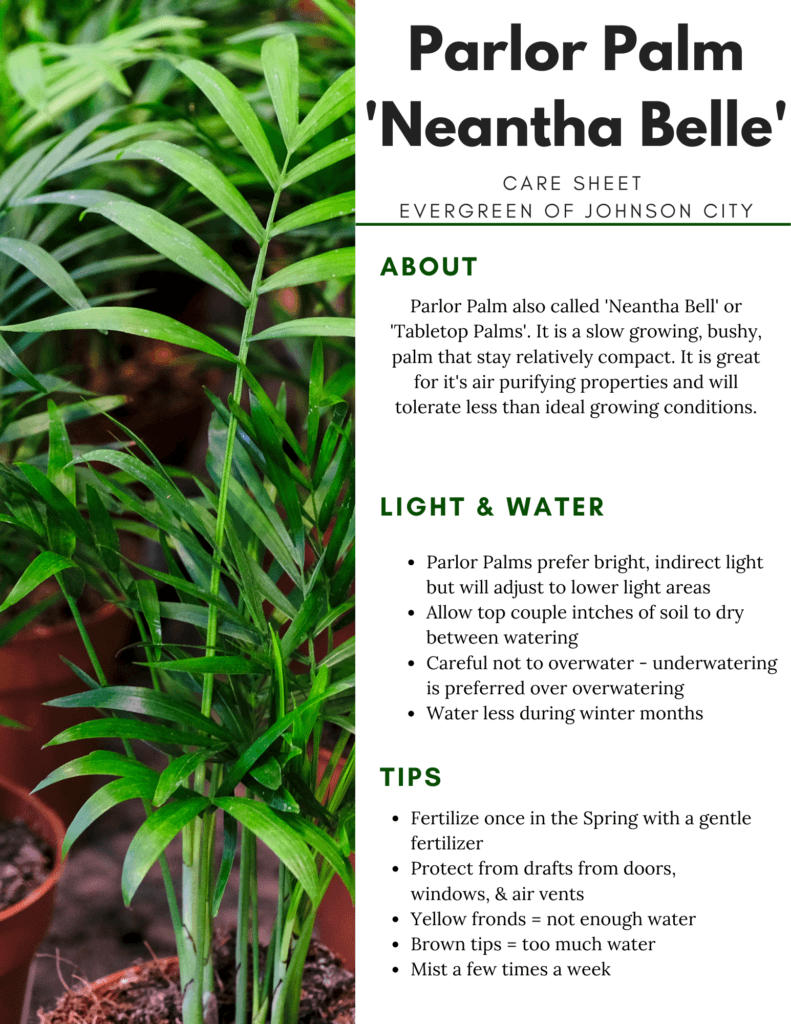
Source evergreenofjc.com
Welcome to our comprehensive guide on how to care for your parlour palm! Whether you’re a seasoned indoor gardener or a beginner, this article will provide you with all the information you need to keep your parlour palm thriving. Parlour palms, scientifically known as Chamaedorea elegans, are popular houseplants due to their beautiful feathery fronds and easy maintenance. With the right care, your parlour palm can add a touch of elegance to any room in your home.
In this article, we will discuss the essential aspects of parlour palm care, including ideal growing conditions, watering strategies, common pests and diseases to watch out for, and helpful tips for troubleshooting. So, let’s dive in and learn how to give your parlour palm the love and attention it deserves!
1. Choosing the Perfect Spot for Your Parlour Palm
Understanding Light Requirements
When it comes to finding the perfect spot for your parlour palm, it’s crucial to understand its light requirements. Parlour palms thrive best in bright, indirect light. While they can tolerate low light conditions, they will not grow as vigorously and may become leggy and weak.
To provide optimal lighting conditions, place your parlour palm near a north or east-facing window, as these directions generally receive less direct sunlight. Avoid placing your plant in direct sunlight as it can scorch the delicate fronds. If you have limited access to natural light, you can also supplement it with artificial fluorescent lights placed about 12-18 inches away from the plant.
Temperature and Humidity
Another crucial factor in parlour palm care is maintaining suitable temperatures and humidity levels. These plants prefer temperatures between 65-75°F (18-24°C), making them well-suited for indoor environments. Avoid exposing your parlour palm to cold drafts or sudden temperature fluctuations, as they can lead to leaf damage.
Additionally, parlour palms enjoy a relatively high humidity level. You can increase humidity by placing a tray filled with water near the plant or using a humidifier. Misting the leaves occasionally can also help create a more humid environment.
2. Watering Techniques for a Happy Parlour Palm
Testing Soil Moisture
Proper watering is vital for the health of your parlour palm. To ensure you’re providing the right amount of water, it’s important to understand how to test soil moisture effectively. Stick your finger about an inch into the soil – if it feels dry, it’s time to water. If it feels moist, it’s best to wait a little longer before watering again.
Avoid overwatering your parlour palm, as it can lead to root rot and other moisture-related issues. It’s better to let the plant dry out slightly between watering sessions to promote healthy root growth.
Watering Techniques
When it’s time to water your parlour palm, ensure thorough watering by pouring water into the pot until it begins to flow out of the drainage holes. Empty any excess water from the saucer or tray to prevent waterlogging. Remember, parlour palms prefer slightly moist soil, not soggy conditions.
3. Fending Off Pests and Handling Common Issues
Common Pests to Watch Out For
Despite their resilience, parlour palms are not immune to pests. Scale insects and mealybugs are among the most common pests that can infest your plant. These unwanted visitors can be controlled with a simple homemade solution of water and mild dish soap. Gently wipe the affected leaves with a cloth or sponge soaked in the solution to remove the pests.
Regularly inspect your parlour palm for any signs of pests, such as sticky residue, tiny webs, or discolored leaves. Early detection and prompt treatment are key to preventing infestations from spreading.
Dealing with Leaf Browning
If you notice the tips or edges of your parlour palm’s leaves turning brown, it may be a sign of low humidity or improper watering. Increase humidity levels around the plant, and adjust your watering routine to maintain consistent moisture without overwatering.
Prune away any brown or damaged leaves using clean pruning shears to promote new growth and maintain the overall aesthetic appeal of your parlour palm.
4. Parlour Palm Care Breakdown
| Aspect | Requirement |
|---|---|
| Light | Bright, indirect light |
| Temperature | 65-75°F (18-24°C) |
| Humidity | High humidity levels |
| Watering | Allow soil to dry slightly between watering |
| Pests | Scale insects, mealybugs |
Frequently Asked Questions
Q: Can I place my parlour palm in direct sunlight?
A: No, parlour palms prefer bright indirect light and can be sensitive to direct sunlight, which may cause their leaves to scorch.
Q: How often should I fertilize my parlour palm?
A: Parlour palms only require fertilization about once every two months during spring and summer. Use a balanced liquid fertilizer diluted to half strength.
Q: Why are the leaves of my parlour palm turning yellow?
A: Yellowing leaves can be caused by overwatering, nutrient deficiencies, or exposure to cold drafts. Evaluate your watering routine, ensure proper feeding, and protect your plant from temperature extremes.
Q: Can I prune my parlour palm?
A: Yes, you can prune your parlour palm to remove any brown or damaged leaves. Sterilize your pruning shears before and after pruning to prevent the spread of diseases or pests.
Q: Is the parlour palm toxic to pets?
A: No, parlour palms are non-toxic to cats and dogs. However, it’s always best to keep an eye on your pets and discourage them from chewing on any houseplants.
Conclusion
Congratulations! You are now equipped with all the knowledge necessary to care for your beautiful parlour palm. Remember to provide it with the right amount of light, humidity, and water, and be on the lookout for any signs of pests or issues. With a little love and attention, your parlour palm will continue to thrive and bring a touch of nature’s elegance into your living space.